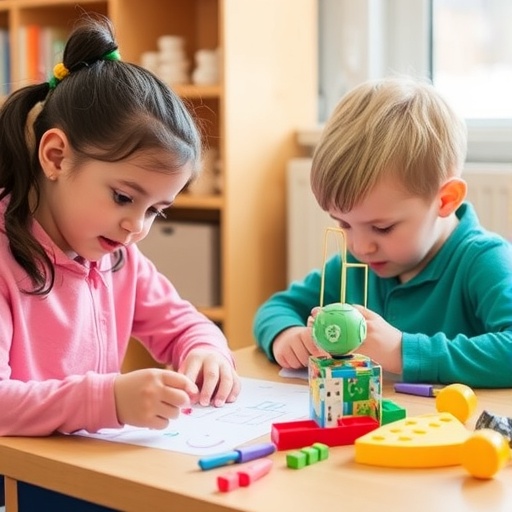In an ever-evolving landscape of education, the intersection of play and learning has garnered significant attention among researchers and educators alike. A recent study delves into this dynamic realm, exploring how playful STEM (science, technology, engineering, and mathematics) learning environments can foster children’s motive orientation. Conducted by researchers including Ramunno, Fleer, and Rai, the findings of this inquiry are set to challenge traditional pedagogical methods and offer new perspectives on curriculum development for young learners.
The research is anchored in the concept of the “Conceptual PlayWorld,” a theoretically driven framework that integrates playful contexts with educational goals. The notion posits that when children engage in play involving STEM concepts, their intrinsic motivation and subsequent learning outcomes can be positively influenced. By creating immersive experiences that seamlessly blend play and learning, educators can tap into children’s natural curiosity and inclination towards exploration.
A key aspect of this study is its cultural-historical analysis, which provides a nuanced lens through which the motives that drive children’s participation in STEM-related activities can be examined. This perspective recognizes the influence of cultural contexts and historical narratives on children’s learning experiences. By considering these dimensions, the researchers aim to illuminate the socio-cultural factors that underpin children’s engagement in play-based learning environments.
Central to the study is the observation of children’s interactions within the conceptual PlayWorld. The findings reveal that children demonstrate heightened levels of engagement and motivation when they perceive STEM learning as a playful endeavor rather than a rigid academic requirement. This shift in perception is crucial, as it suggests that educators may need to reevaluate how they present STEM subjects to young learners. By framing these subjects in a playful context, they can foster a more positive attitude towards learning that extends beyond the classroom.
Moreover, the study underscores the importance of intentional teaching strategies that capitalize on these playful interactions. Educators are encouraged to facilitate opportunities for exploration, problem-solving, and collaboration among students. This can be achieved through carefully designed activities that encourage curiosity and creativity while embedding STEM concepts within the play framework. The implications for practice are profound, as they suggest a transformative shift towards a more holistic approach to education.
An interesting finding from the research is the role of social dynamics in children’s motive orientation towards STEM learning. The collaborative nature of play allows children to negotiate roles, share ideas, and challenge one another’s thinking. Through these interactions, they not only learn STEM concepts but also develop critical social and emotional skills. This dual focus on both cognitive and social development sets the stage for a more comprehensive understanding of children’s learning processes.
Additionally, the study discusses the role of educators in creating an environment that supports playful learning. Educators are not merely facilitators of knowledge but play architects who design experiences that resonate with children’s interests and passions. This redefined role positions teachers as key figures in fostering a culture of inquiry and creativity within the classroom. By investing in professional development aimed at enhancing educators’ understanding of playful learning, schools can build more resilient and adaptive learning environments.
As the educational community continues to grapple with the ramifications of the digital age, the findings of this study serve as a timely reminder of the importance of play in children’s development. In a world increasingly dominated by technology, it becomes essential to preserve spaces where children can engage in unstructured, meaningful play. This research advocates for integrating technology into play without overshadowing the fundamental importance of social interactions and imaginative exploration.
The cultural-historical analysis also reveals how children’s experiences of play are shaped by their backgrounds, community values, and social contexts. Recognizing these factors is critical in developing inclusive educational practices that cater to diverse learning needs. As educators seek to implement playful STEM learning strategies, they must remain attuned to the varied experiences and motivations that children bring into the classroom.
Furthermore, the implications of this research extend beyond the classroom. As stakeholders in education—parents, policymakers, and communities—recognize the potential of playful learning, they can advocate for policies and initiatives that promote these practices. Partnerships between schools and communities can facilitate access to resources and support systems that enhance playful learning opportunities for all children. Collaboration among educators, parents, and community members can create a robust network that champions the importance of combining play with STEM education.
The study also opens avenues for future research in several areas. For instance, longitudinal studies could track the long-term effects of playful STEM learning on academic achievement and personal development. Investigating how different cultural contexts influence children’s experiences of play and learning could further enrich the field. Understanding these variables allows researchers to refine the conceptual PlayWorld framework, making it more applicable across diverse educational settings.
In conclusion, the transformative potential of playful STEM learning outlined in this research cannot be overstated. By merging play with rigorous academic inquiry, educators can cultivate a generation of learners who are not only knowledgeable in science, technology, engineering, and mathematics but also possess the critical thinking and social skills necessary for lifelong learning. The findings advocate for a paradigm shift in education that prioritizes playful engagement while recognizing the intricacies of children’s motives and cultural contexts.
As our understanding of educational practices evolves, it is imperative that we embrace the playful dimensions of learning. This study serves as a clarion call for educators to rethink their approaches, inhale the fresh air of creativity, and inject playfulness into their pedagogies. Only by doing so can we hope to inspire young minds to not just learn but to thrive in an increasingly complex world.
Subject of Research: Playful STEM Learning
Article Title: Playful STEM Learning: A Cultural-Historical Analysis of a Child’s Motive Orientation within a Conceptual PlayWorld
Article References:
Ramunno, O., Fleer, M., Rai, P. et al. Playful STEM Learning: A Cultural-Historical Analysis of a Child’s Motive Orientation within a Conceptual PlayWorld.
IJEC (2025). https://doi.org/10.1007/s13158-025-00451-3
Image Credits: AI Generated
DOI: 10.1007/s13158-025-00451-3
Keywords: Playful Learning, STEM Education, Conceptual PlayWorld, Child Development, Cultural-Historical Analysis




